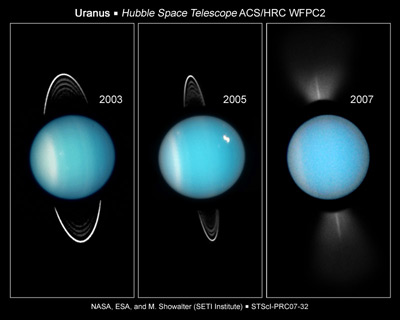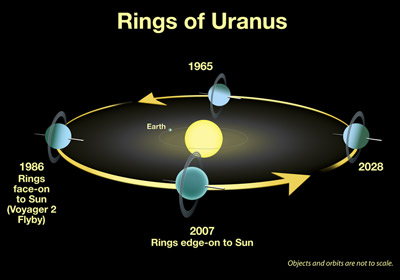24 August 2007

NASA recently published an intriguing series of images from the Hubble Space Telescope (HST), demonstrating the varying tilt of the faint rings of Uranus, the distant giant planet.
On the image (at right), the rings are visible edge-on. The best opportunity to view the edge-on aspect of the Uranian rings in 2007 was actually recorded in this image. It was acquired on 14 August 2007, applying HST's planetary camera, the WFPC2.
The edge-on rings appear as two spikes emanating from the planet. The rings are apparently not fully encircling the planet, as the bright glare of the planet has been blocked out (a little remaining glare appears as a fan-shaped image artifact). A shorter-exposure, color image of Uranus has been superimposed on the image to reveal the planet's size and position relative to the ring plane.
On 7 December 2007, the Uranian rings will be perfectly edge-on as viewed from the Sun. This will mark the beginning of northern spring on Uranus.

The Orientation of the Uranian Rings from 1965 to 2028
Credit: NASA, ESA, and A. Feild (STScI)
The edgewise aspect of the Uranian rings occurs every 42 years, or twice over the 84-year long orbit of Uranus around the Sun. Interestingly, the last time the rings were edge-on relative to Earth was not observed at all, as the rings were discovered only 30 years ago!
Astronomers hope that the Hubble data would enable the detection of new small moons of Uranus near the rings. Before the Hubble era, the only detailed views of the Uranian rings were relayed by the Voyager 2 spacecraft in January 1986. Applying advanced techniques, such as the "adaptive optics", Earth-based astronomers can now obtain good views of the mysterious rings.
Uranus (approximately 50,000 km across) is nearly 3,000 million km from Earth! It is the seventh planet from the Sun. It has 27 moons. Its axial tilt is about 98°. Therefore, the planet's axial rotation is in a sense opposite to that of Earth. An amazing consequence of the axial tilt of Uranus is that each of the poles of the planet is in continuous sunlight for 42 years, followed by 42 years of continuous night, over a complete revolution of Uranus around the Sun. The Uranian rings were discovered in 1977, when the planet passed in front of a star.
Further Reading
NASA's Hubble Discovers New Rings and Moons Around Uranus
http://hubblesite.org/newscenter/archive/releases/2005/33/
Hubble Uncovers Smallest Moons Yet Seen Around Uranus
http://hubblesite.org/newscenter/archive/releases/2003/29/
Uranus
http://www.nineplanets.org/uranus.html
Aymen Mohamed Ibrahem
Senior Astronomy Specialist